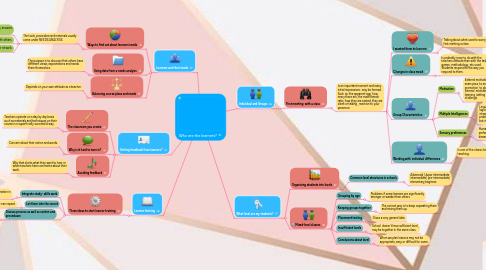
1. Learners and their needs
1.1. Ways to find out about learners´needs
1.1.1. The tools, procedure and materials usually come under NEEDS ANALYSIS.
1.1.1.1. Writing: comments, information, answers and questions.
1.1.1.2. Speaking: speaks with you or with others.
1.1.1.3. Observing: observe the learner at work.
1.2. Using data from a needs analysis
1.2.1. The purpose is to discover that others have different views, expectations and needs them themselves.
1.3. Balancing course plans and needs
1.3.1. Depends on your own attitude as a teacher.
2. Getting feedback from learners?
2.1. The classroom you create
2.1.1. Teachers operate on a day by day basis such as materials and techniques on their course is a superficially successful way.
2.2. Why is it hard to tune in?
2.2.1. Concern about their action and words.
2.3. Avoiding feedback
2.3.1. Way that elicits what they want to hear or when teachers hear comments about their work.
3. Learner training
3.1. Three ideas to start learner training
3.1.1. Integrate study- skills work
3.1.1.1. Short excercises that involve information in a diccionary.
3.1.2. Let them into the secret
3.1.2.1. A methodology that they can repeat.
3.1.3. Discuss process as well as conten and proceduare
3.1.3.1. Simply talking about new ideas or solutions.
4. Individual and Groups
4.1. First meeting with a class
4.1.1. Is an important moment and many initial impressions may be formed. Such as: the apparent age, how many there are, the male/female ratio, how they are seated, they are silent or talking , reaction to your presence.
4.1.1.1. I wanted them to love me
4.1.1.1.1. Talking about what used to worry when first metting a class.
4.1.1.2. Changes in class mood
4.1.1.2.1. Is probably more to do with the teachers attitude than with the task, games, methodology, etc used. Students respond to the way you respond to them.
4.1.1.3. Group Characteristics
4.1.1.3.1. Motivation
4.1.1.3.2. Multiple Intelligences
4.1.1.3.3. Sensory preferences
4.1.1.4. Working with individual differences
4.1.1.4.1. Is one of the classic balancing acts of teaching.
5. What level are my students?
5.1. Organizing students into levels
5.1.1. Common level structures in schools
5.1.1.1. Advanced, Upper intermediate, intermediate, pre-intermediate, elementary,beginner.
5.2. Mixed-level classes
5.2.1. Grouping by age
5.2.1.1. Problems if some learners are significantly stronger or weaker than others
5.2.2. Keeping groups together
5.2.2.1. The correct way is to keep separating them and mixing them up.
5.2.3. Placement testing
5.2.3.1. Gives a very general idea.
5.2.4. Insufficient levels
5.2.4.1. School doesn't have sufficient level, may be together in the same class.
5.2.5. Conclusions about level
5.2.5.1. When we plan lessons may not be appropriate, easy or difficult for some.

